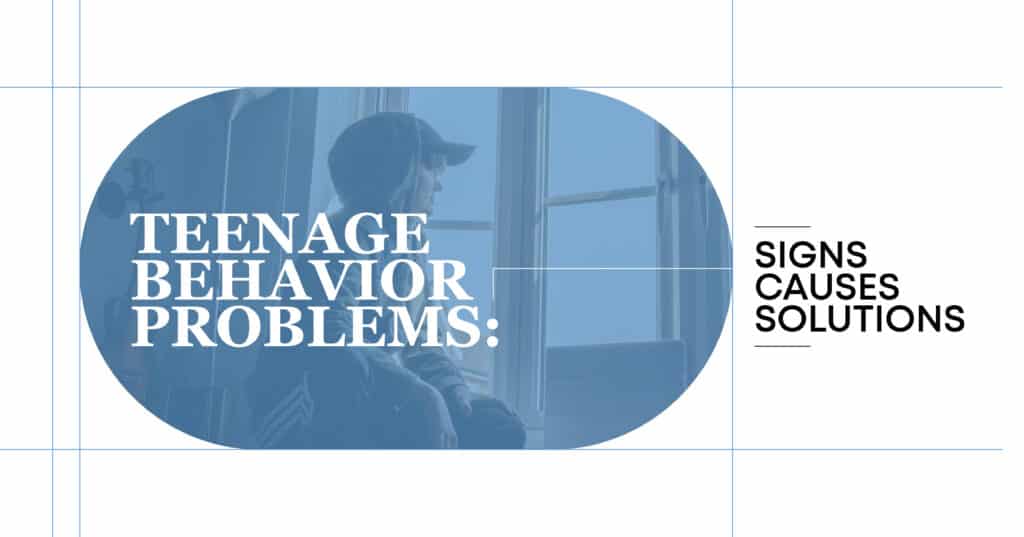Most of us would agree that raising a teenager is often a perplexing combination of love, anger, pride, and confusion. For example, a seemingly carefree and giggling teen can transform into a grumpy individual who storms off to their room and slams the doors behind them seconds later.
Parents are often left wondering why these abrupt changes could be. This suspicion is further clouded by wondering whether they’re witnessing normal teenage behavior vs abnormal. Understanding behavioral problems in teenagers starts with differentiating between typical development and red flags of more serious issues.
Understanding Teenage Behavior Problems
During any stage of development, there is bound to be a significant change to adapt to. For teenagers, their bodies, social connections, and mental capabilities are proliferating. Adapting to change can be difficult, but it is one more boost towards independence for children.
It is not uncommon for adolescents to start second-guessing their parents, embrace authority, or feel emotions. Although these changes can set off alarm bells to the parent, their child is adjusting to the upcoming changes. In this case, most youngsters go through a shift where they are moody and withdrawn, with no apparent reason for feeling how they think.
What’s Typical – and What Might Need Attention
In every adolescent we know, seeking privacy, prioritizing friends over family interactions, and expressing opinions with greater intensity are common behaviors. These actions stem from efforts to form an identity.
In contrast, severe temperament shifts, diminished interest in previously enjoyed activities, and continued rebelliousness may not align with standard teenage behavior. Distinguishing typical versus atypical teen behavioral patterns is critical to determining when support should be offered.
Hillside Horizon
Common Signs of Behavior Issues in Teens
Every young adult is distinct in their way, but there are general signs that indicate a young adult is having a tough time coping with the stresses of adolescence. Profound anger, emotional outbursts, and habitual rule infractions suggest deep-seated issues.
Some young adults may completely withdraw from socialization with friends and family. They show limited interest in school or activities that they used to excel in. These concerns may arise differently based on the person’s character, surroundings, and sexual identification. A typical teenage girl will show emotional withdrawal together with harsh self-talk, overbearing behavior, and distress signals that she expresses when alone.
Boys typically display their frustration through external actions, including angry outbursts and defiant behavior. Basic principles for proactive teenage behavior problem management include monitoring and identifying changes in your child’s behavioral patterns.
Causes Behind Teenage Attitude and Defiance
The solution requires identifying fundamental causes behind adolescent behavior and attitude development. Adults often mistake genuine teenage emotions, but teenagers use these behaviors to cope with hidden conflicts, frustrations, and fears.
A teenager’s brain experiences multiple developmental changes that affect decision-making abilities and impulse control systems. This natural development leads to frequent overreactions, mood swings, and impulsive, dangerous choices.
Apart from the biological factors, there are also outside reasons which have a significant impact. The familial picture adds a great deal of emotional stress: parental disputes, divorce, and the death of significant others are all a part of it.
Adolescents are often ill-equipped to deal with these situations, and their inability to process the problem leads to distress, which manifests as withdrawal and rebellious behavior.
School stressors, academic expectations, and identity development create tension, which feeds into negative patterns. The outbursts or shutdowns that occur frequently stem from unresolved trauma and anxiety, depression, and ADHD. Teenagers often hide their internal conflicts behind behavioral problems, but they remain silent about their need for help.
The Line Between Normal and Concerning Behavior
Normal teenage behavior includes demanding independence and testing authority while occasionally displaying crankiness. Such behaviors are annoying but do not warrant concern. Attributing these behaviors to growing pains becomes difficult when they occur frequently or intensely and when they interfere with academic performance, relationships, or personal safety.
Assessing typical teenage behavior problems and abnormal behavior needs to be viewed from a broader perspective. The usual adolescent development includes when your teenager challenges curfew rules and occasionally forgets assignments.
The situation requires serious attention when your teenager shows persistent lies about their location and school absences and displays violent outbursts and total social withdrawal. Early detection of emotional warning signs, which include persistent sadness and loss of interest, together with verbal expressions of hopelessness, becomes essential because they may indicate underlying mental health issues.
Hillside Horizon
How Peer Pressure and Social Dynamics Play a Role
Social acceptance becomes the primary concern for most adolescents. During adolescence, people use social interactions to evaluate their self-perception, leading to substantial behavior changes.
Teenagers tend to adopt particular behaviors primarily because they believe these actions are essential for gaining social approval or preventing social isolation. The social environment of school and online platforms controls every aspect of their behavior, including their school attire and their home conduct.
Peer pressure tends to worsen behavioral issues in adolescents. This is especially the case when they’re stuck in the company of those who indulge in risk-taking, secrecy, or general rule-breaking.
Those pressures extend well beyond the confines of the school building. With the help of social media, such pressures now intrude into a teen’s room, their social feeds, and even their perception of self. It becomes rare for adolescents to respect boundaries solely because doing so would mean presenting themselves as “lame” or “uncool,” which is not an image they want to associate themselves with.
Teens tend to behave more maturely when they are surrounded by peers who have a positive influence on them. Such teens are going to be better at managing their emotions and making healthier decisions. Understanding the context of your teen’s behavior requires understanding the influence of such social dynamics.
Strategies Parents Can Use to Handle Teenage Defiance
Your teenager may appear to be rebelling against you, but most teens need support, structure, and love even though they express it poorly. Handling teenage behavior and attitudes needs patience, empathy, and consistency.
The most effective approach is to maintain calm communication, even when your teen is anything but peaceful. Anger or frustration reactions tend to escalate situations, but a quiet tone with clear expectations helps defuse tension and opens the door to more constructive conversations.
Also, focus on creating moments of connection that aren’t tied to behavior correction. These shared experiences of watching a show, driving, or eating out create an emotional foundation that makes later conversations more effective. If your teen feels you genuinely care about their behavior, thoughts, and feelings, they’re more likely to let you in when it matters most.
Can Therapy Help With Teenage Behavior Problems?
Professional assistance becomes necessary when adolescent behavioral problems advance to specific levels of complexity because it creates substantial relief for both teenagers and their entire families.
The therapeutic environment creates a protected space where teenagers can express their feelings while discovering their fears and developing better methods to handle stressful and conflict-based situations. Teenagers tend to avoid open discussions with their parents about personal matters. Still, they often find it easier to disclose information to therapists without connection to their personal history.
The therapeutic approach includes various delivery methods, which include individual emotional self-regulation therapy as well as family communication therapy and group therapy sessions that help adolescents understand others who share similar difficulties.
These strategies are most effective when behavior problems during adolescence are related to underlying anxiety, depression, trauma, or other mental health issues that are not immediately apparent. Behavior that is labeled as rebellious is often a survival mechanism for emotionally intense experiences that a teenager does not yet have the words to express.
What Support Might Look Like at This Age
Intentionally scaffolding support for adolescents does not need to be overly complex. Whether it concerns peer interactions, identity development, or school behaviors, adolescents can benefit from support services such as counseling, mentoring, or educational coaching. Remember, the most important message to your adolescent is that they are not alone, and seeking help is a sign of strength, not weakness.
Concerned About Your Teen’s Behavior? Hillside Horizon for Teens Is Here to Help
We understand how difficult it can be dealing with such challenges at Hillside Horizon for Teens and what steps to take next. As a parent, you may not have the answers to why your child is dealing with defiance, worse, anxiety, emotional pain, or more, but rest assured, we’re here to help.
Every young adult is different and has unique requirements that must be met. Therefore, we don’t embrace a systematic approach to therapy, and each teen is treated individually according to their specific needs.
With individual therapy, family involvement, and strategy sessions, we reestablish the calm and connected state within a home that feels chaotic and hopeless. Change is possible no matter how complex the problem appears to be. We’ll partner with you on this journey.
Hillside Horizon
FAQs
What are common teenage behavior problems?
Some typical problems are volatile moods, persistent defiance, aggressiveness, withdrawal, substance use, or avoidance of school and other forms of risky activities. These problems may differ based on the individual’s traits, surroundings, and mental well-being.
How do I know if my teen’s behavior is normal?
Normal and abnormal behavior in teens differs by the act’s normalization, routineness, intensity, and destructive nature. Now and then, a teenager may be disobedient or overly sulky, which is fine, but recurring, destructive behaviors may signal more serious problems.
How can parents handle teenage defiance?
Try to manage teenage defiance by calmly applying boundaries, listening actively, and fostering connection beyond conflict. Therapy and outside help can also aid in resetting family structures.
Can therapy help with teenage behavior problems?
Correct. Therapy equips teenagers with strategies for emotional regulation, relationship management, and self-perception. In addition, it can help foster healthier communication patterns among family members.
How does peer pressure influence teen behavior?
Social influence may be used to reinforce good behavior or promote riskier behavior. Social group dynamics greatly influence teenagers’ behavior, particularly regarding identity formation and decision-making.





